Index

Review: OC results guranteed, provided you buy EVBot too
We spent some time over the weekend getting to know EVGA’s GTX 680 Classified a bit better and the review is finally ready. The GTX 680 Classified has ultimately produced the highest overclock we’ve managed on a GTX 680, but only after using the EVBot to overvolt the card. We were still a bit disappointed in general as the GTX 680 didn’t fully meet our expectations, and you’ll soon see why.
Before we move on, we’d like to inform our dear readers, who think that we intentionally left out AMD’s fastest cards, that we’re expecting Sapphire’s HD 7970 VaporX in our lab, so we’ll include it in the tables as soon as possible. Besides, our mission today is to show the GTX 680 Classified in all its glory, rather than engage in red vs. green debates.
EVGA GTX 680 Classified is much different than the reference design. The company added 10 additional phases for the GPU, bringing it up to 14-phase power. The company used a wider and longer PCB with a cooler that was also made bigger, whereas the memory capacity was doubled. The last detail is the EVBot connector, which can be used for sensor readouts as well as overvolting.
EVGA selected only the best GK104 chips. Naturally, OC results greatly depend on quality of graphics chips, since not all will handle extreme clocks. Still, even though all graphics chips aren’t equal, you can bet that the chips running GTX 680 Classified cards will work better than average. The GTX 680 Classified comes with a factory overclock, where Base GPU clock ended up at 1111MHz. So, although the GTX 680 Classified is EVGA’s fastest air-cooled card, 1111MHz won’t earn it the title of the fastest factory overclocked GTX 680.
The memory was left at reference clocks, meaning 1502MHz (6008MHz effectively), whereas the capacity is up from standard 2GB to 4GB. Although the card’s memory was doubled, it wasn’t overclocked so the bandwidth stands at 192.3GB/s.
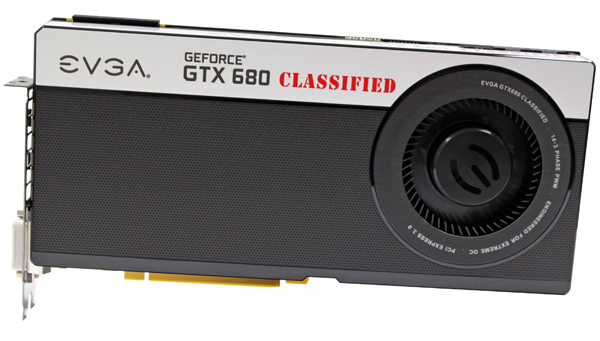
EVGA threw in two 6-pin-to-8pin power cables that look great but what we'd really like to see is something along the lines of gift EVBot device.
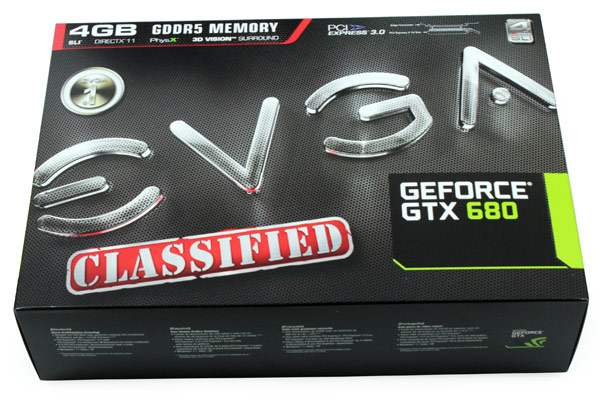
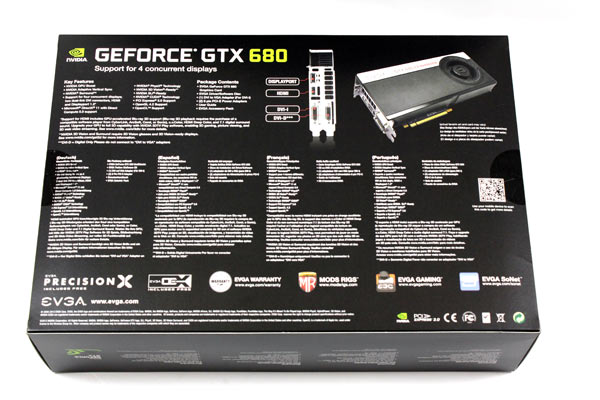
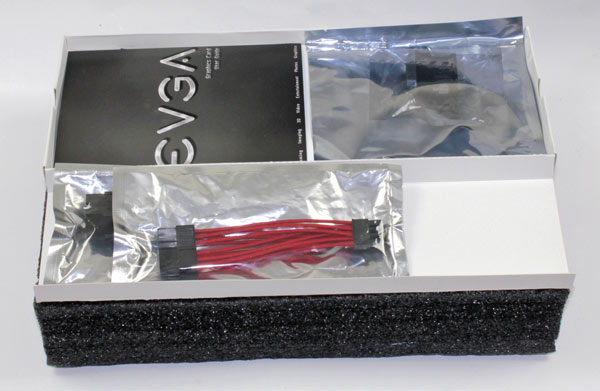
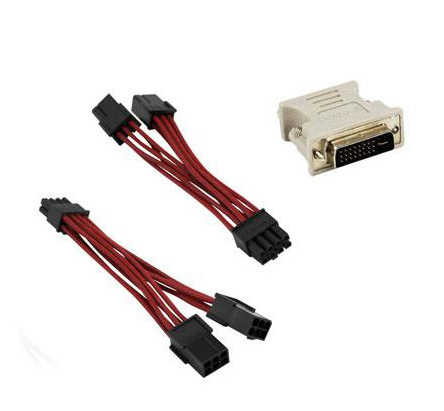
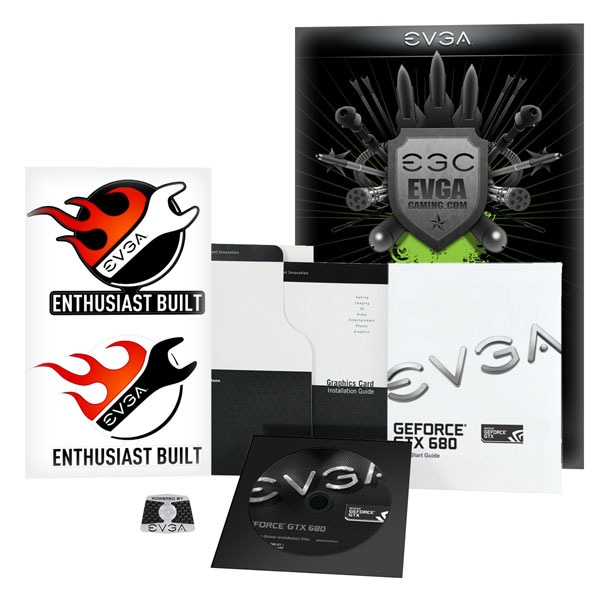
The GTX 680 Classified is bigger than the reference card, but is designed to take up two slots in width. At the same time, this allows enthusiasts to chain up to four GTX 680 Classifieds in Quad SLI. The Classified’s cooler is a touch up of the reference (GTX 580) cooler, where EVGA extended the heatsink and replaced the 6.5 fan with an 8cm one.
Many of Nvidia’s partners have gone with dual fan coolers in order to keep thermals in check. In fact, thermals tend to be the biggest limitation in overclocking GTX 680s, so some companies threw in three or more fans. Naturally, such cards are wider than two slots, so you can forget about Quad SLI.

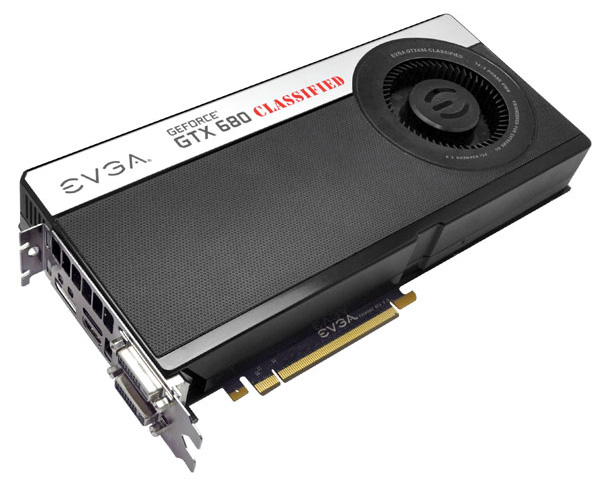
The fan has a speed limit and it won’t go faster than 55%, i.e. more than 3240 RPM. Although factory overclocked, the GTX 680 Classified was a bit quieter than the reference model, in other words – it’s quiet.
On the back you see GDDR5 memory modules that were added to double the capacity to 4GB.
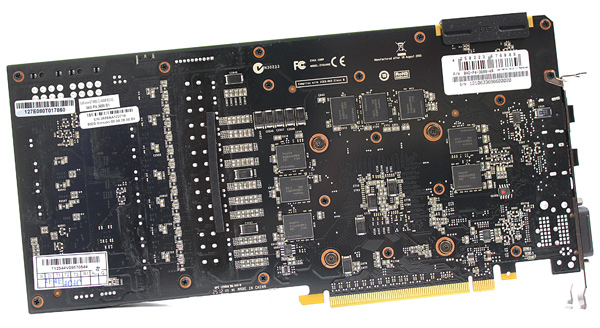
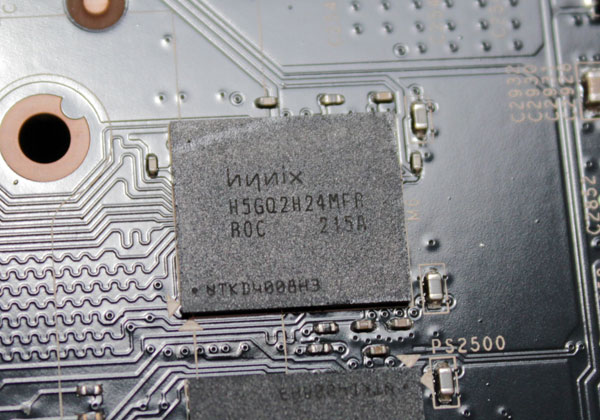
The plastic shroud isn’t difficult to take off, especially since the cooler is very similar to the reference one.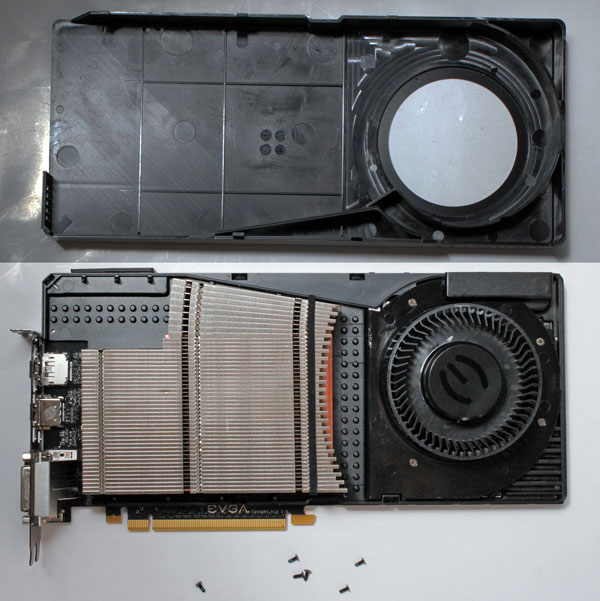
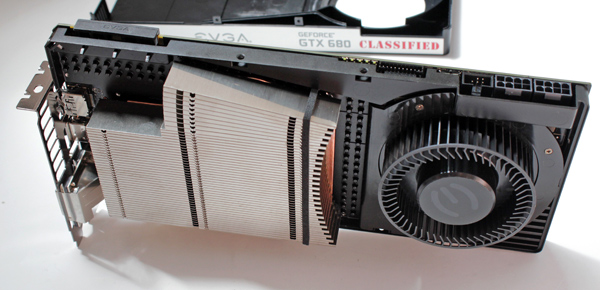
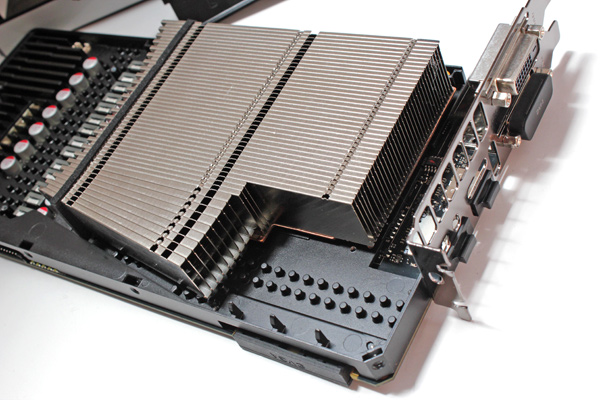
The fan is taken off easily, which should come in handy come cleaning time.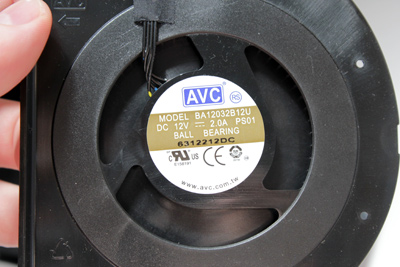
EVGA made the heatsink wider and once we took it off, we saw that the GTX 680 Classified uses Vapor Chamber technology (reference GTX 680 cards come with regular, copper blocks). The cooler also has a Vapor Chamber heatpipe that helps with heat distribution. All in all, the cooler looks much like the one on GTX 580 cards.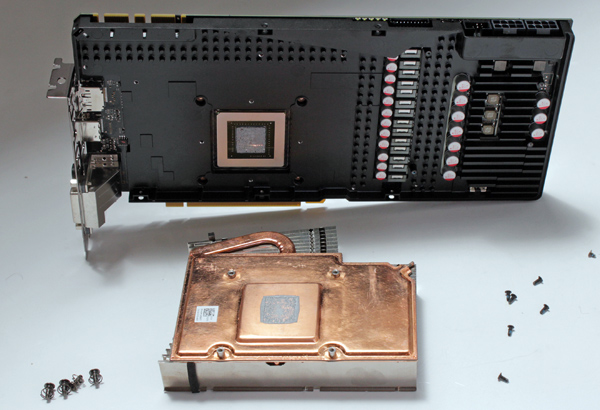
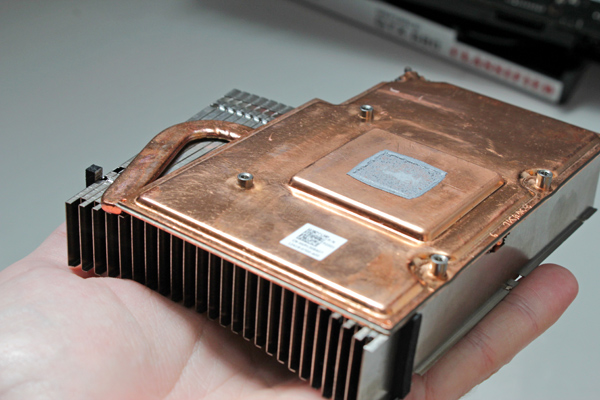
The memory is cooled by a large heatspreader, which spans the entire PCB and does a good job of reinforcing it. The power components are easy to spot and you can count 14 phases yourself. The Classified packs a 14+3 phase VRM, whereas the reference card has 4+2 VRM.
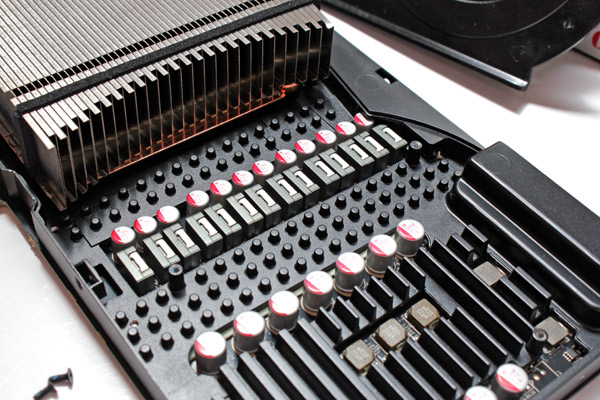
Overclocking and overvolting requires power, so the card comes with two 8-pin connectors. Factoring in the power it gets via PCI Express, the Classified can draw up to 375W. Note that reference cards come with one 6-pin and one 8-pin connector, allowing for 300W.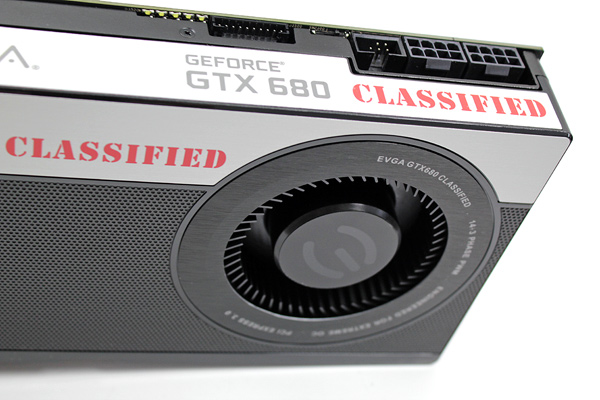
Among the features that make the Classified stand out is the EVBot connector, which is right next to the power connectors. Note however that the EVBot is purchased separately. We hooked it up to the card via a 105cm long cable and used it to boost the voltage beyond 1.175v (advised at 0.0625v increments).
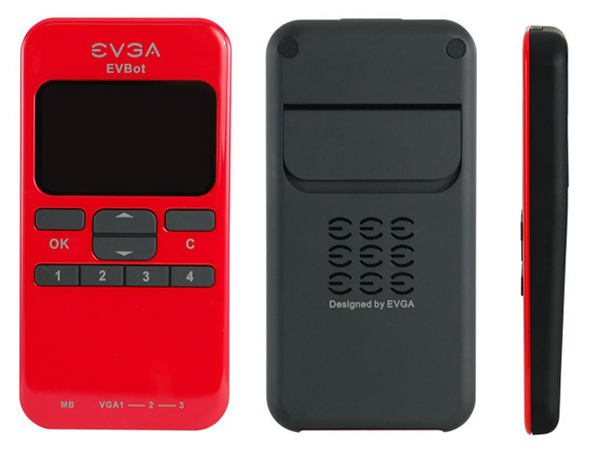
GTX 580 Classified’s EVBot connector was on the I/O panel, but we like the new placement as well. Besides, most new cases come with watercooling holes, which can be used to route the cable from the back.
The GTX 680 Classified isn’t short on interesting features, and the BIOS switch next to the EVBot connector is one of them. The switch offers Normal, OC and LN2 BIOS’, LN2 mode disables some power protections for extreme overclocking. Unfortunately, it didn’t help with extreme overclocking as the cooler quickly turned out to be the choke point.
Voltage monitoring header gets quite handy when overvolting, and you’ll find it next to the BIOS switch (EVGA will make a small adapter separately that will make voltage probes able to attach easily).
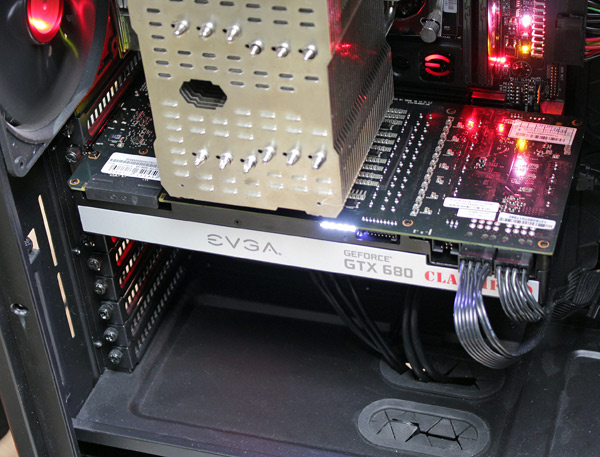
The I/O panel holds standard HDMI and DisplayPort connectors, as well as two dual link DVI outs, just like on the reference GTX 680 cards. EVGA made the I/O panel air exhausts bigger to improve airflow but one part of the cooler will stay behind. Unfortunately, this means that some of the hot air will remain in the case.
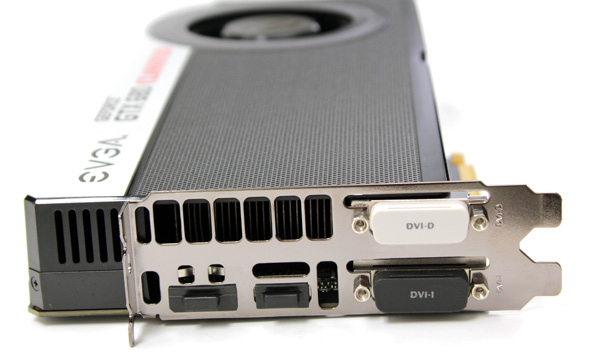
Motherboard: EVGA X79 FTW
CPU: Sandy Bridge-E Core i7 3820 (3.6GHz)
CPU Cooler: Thermalright HR-02 (Thermalright-Europa Distri www.PC-Cooling.de).
Memory: 8GB ADATA DDR3 1600 XPG Gaming series
Harddisk: OCZ Vertex 2 100 GB
Power Supply: CoolerMaster Silent Pro 1000W
Case: CoolerMaster Cosmos II Ultra Tower
Operating System: Win7 64-bit
Nvidia 304.79-desktop-win7-winvista-64bit-english-beta
AMD 12-6_vista_win7_64_dd_ccc.exe
Overclocking results for the GTX 680 Classified that you see in the tables were scored at 1161MHz (max boost 1238MHz) / 6008MHz. However, we could've scored the same without using EVBot at all.

3D Mark 11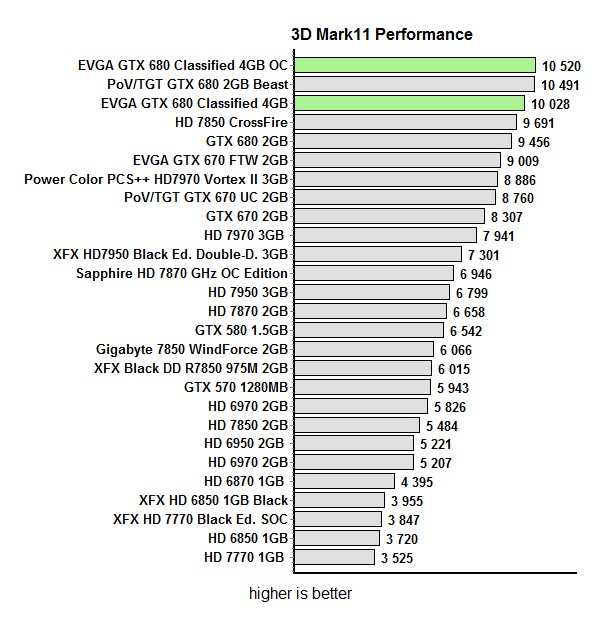
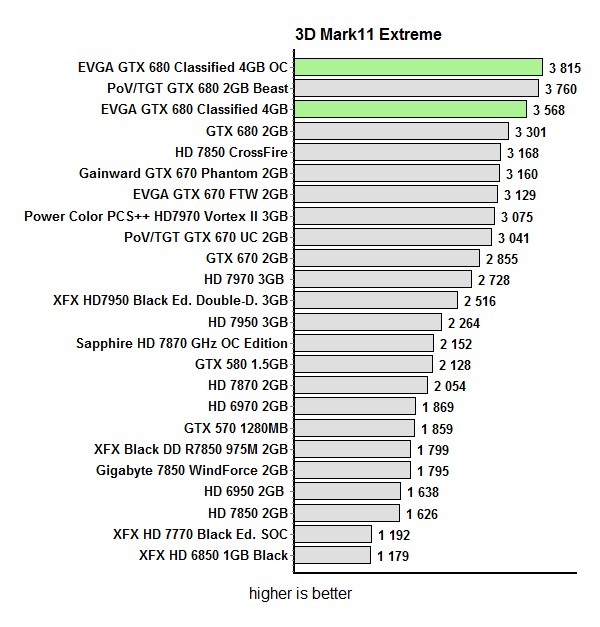
Crysis 2
Overclocking results for the GTX 680 Classified that you see in the tables were scored without overvolting at 1161MHz (max boost 1238MHz) / 6008MHz.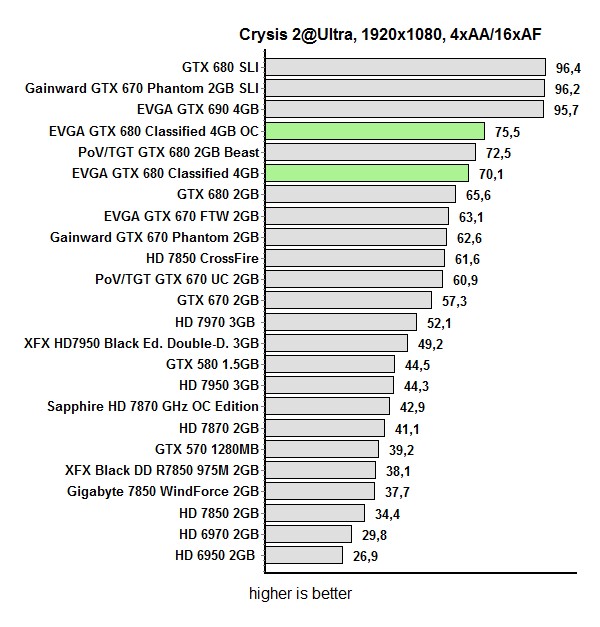
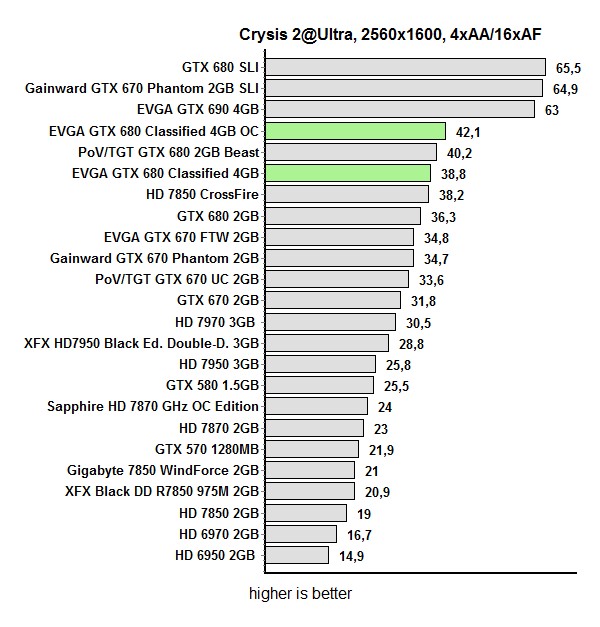
Aliens vs Predator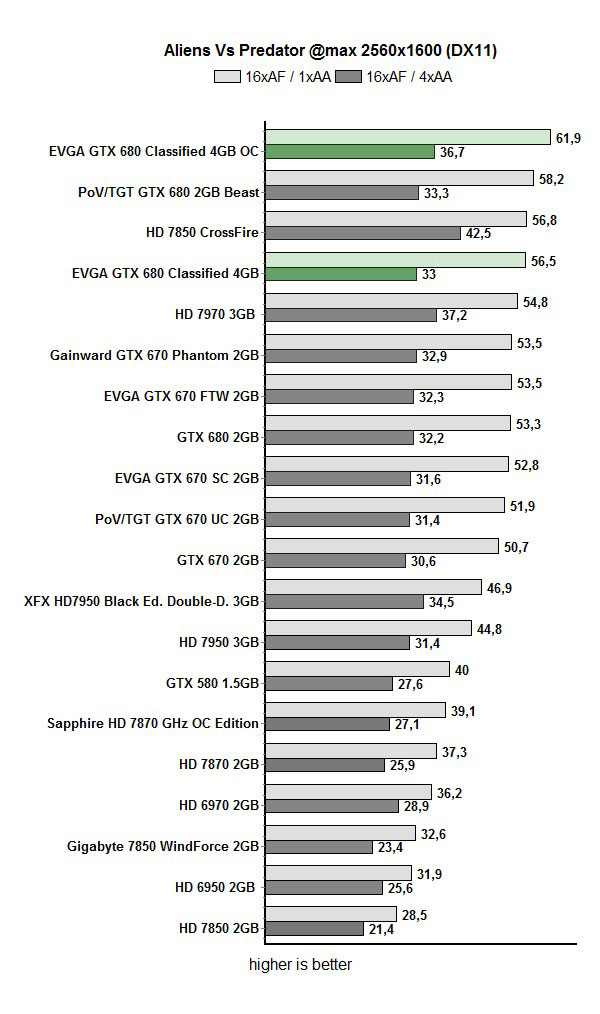
Metro 2033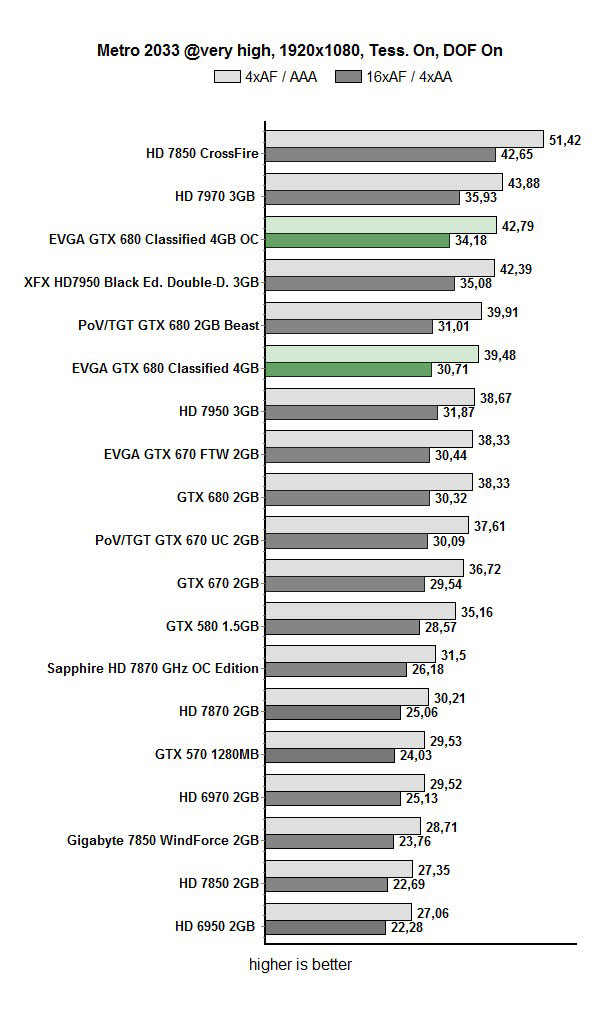
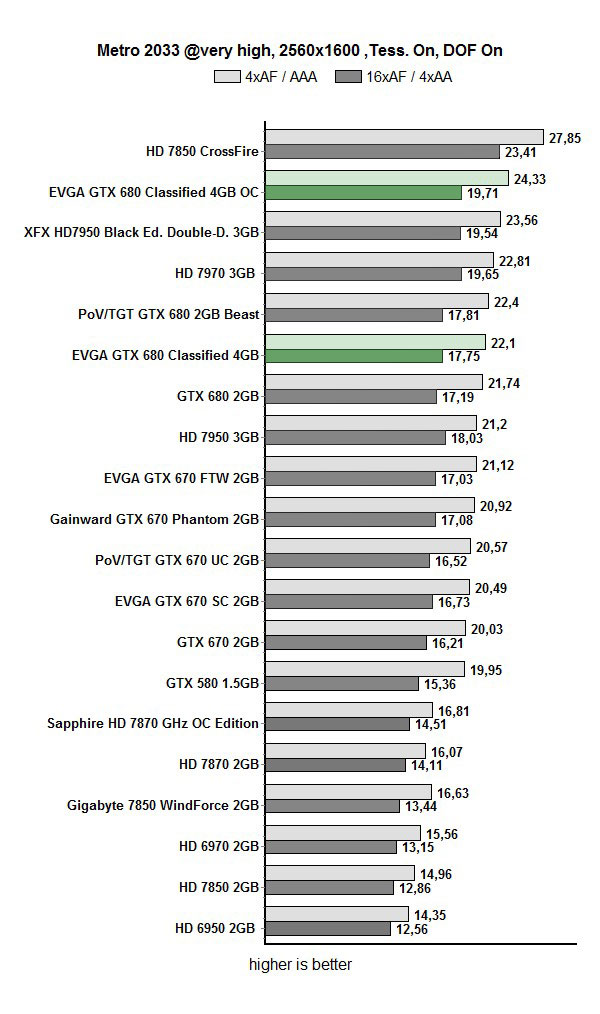
Unigine Heaven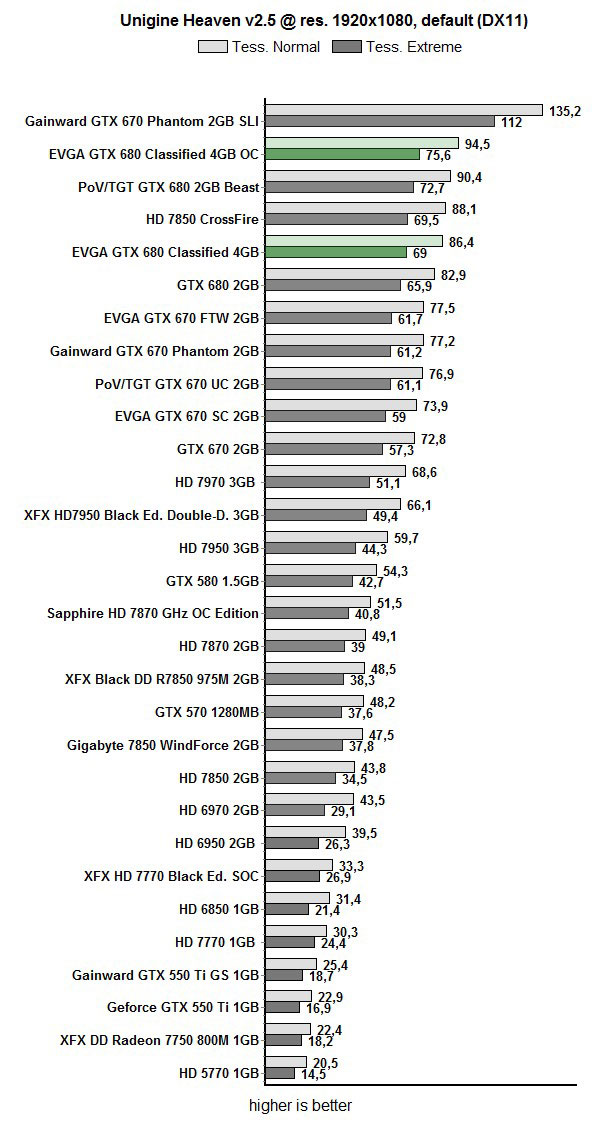
We split the OC part into two sections because we used PrecisionX software and EVBot overclocking device. As we said earlier, EVBot is purchased separately, one more reason to take a closer look at it. Users who don’t have EVBot will have to resort to software tools, but note that we couldn’t overvolt the GPU without the EVBot.
EVGA didn’t mess with GPU voltage on the Classified, which means that the maximum is set at 1.175v. Nvidia cited security reasons behind its insistence on specified values, claiming that it guarantees only for cards and GPUs operated within the specified voltage limits. This means that a product will not pass "NV green light" when OVed, as it will exceed the maximum power consumption and maximum heat dissipation. This is why EVGA didn’t launch an OVed Classified, but rather went for the EVBot, which can boost the voltage all the way up to 1.850v. Also warranty is not impacted by using EVBot.
Using only PrecisionX tool and not the EVBot, we overclocked the Base GPU clock by +50MHz. Although this may not seem impressive at first, the card is already overclocked to 1111MHz, making ours quite a decent result of 1161MHz (Max Boost clock at 1238MHz). It’s also important to note that no two GPUs will overclock/score identically. It appears as if we weren’t particularly lucky with our GPU, because we expected more. In comparison, we overclocked our GTX 680 Signature to 1185MHz.
The memory isn’t overclocked, so we’re talking 1502MHz (6008MHz effectively). The GTX 680 Classified comes with 4GB of memory distributed across 16 chips.
Overclocking the memory spells more bad news for the maximum GPU clock, even more so for cards packing 4GB. Memory also gets hot and consumes power, which may result in hitting maximum TDP and thermal limit faster. We’d still advise you to overclock the memory, especially if you’re interested in gaming performance. In fact, increasing the bandwidth occasionally yielded bigger performance boosts than the same card with only its GPU overclocked.
4GB cards come with a realistic chance that one of the chips won’t be in the “mood” for overclocking, making its clock the limitation for overclocking. The maximum memory clock without overvolting was at about 6800MHz.
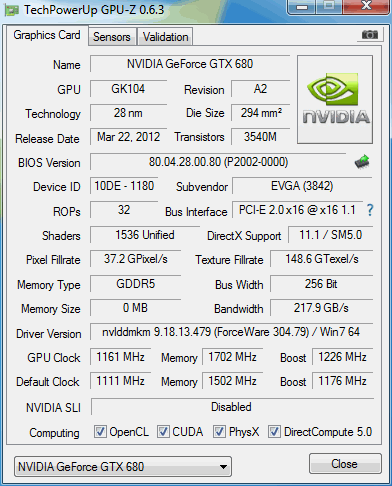
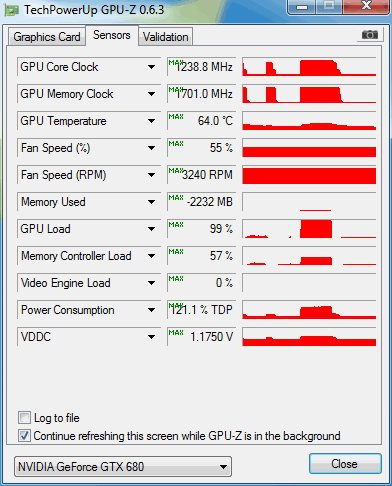
EVBot’s last firmware version includes support for overclocking the GTX 680 Classified and Classified SR-X motherboard. You can tell whether your hardware supports the EVBot by looking for the 5-pin EVBot connector. The user manual is a bit unclear as it only lists options, without detailed descriptions. Of course, users can always find more info on EVGA’s portal, here,, but it should be said that EVGA aimed EVBot at experienced users that know what to do.
If you want to order the EVBot, we’d first recommend checking whether it’s running latest firmware that recognizes the GTX 680 Classifed. If not, you can flash it via any EVGA motherboard with an EVBot connector, otherwise it will be useless for the Classified.
The EVBot connects to the card via a 105cm cable. It can run three graphics cards and one motherboard simultaneously.
EVBot allows for overvolting NVVDD (GPU voltage), FBVDD (memory voltage), PEXVDD1 (PCI-Express voltage #1), PEXVDD2 (PCI-Express-voltage#2) and OCP (Over-Current-Protection with Normal or Extreme settings).
Overclocking without overvolting wasn’t quite phenomenal – we only managed 1161MHz (max. boost clock 1238MHz). EVbot managed 1250MHz (max. boost clock 1329MHz) at 1.268v. Running at these clocks, Boost clock was pretty maxed out. At higher clocks we encountered occasional downclocking.
It seems as if the cooler was what kept us from improving our results. We noticed that the card downclocks as soon as it hits 79°C. Unfortunately, this critical threshold is easily hit at clocks above 1350MHz (boost clock), such as by playing a more demanding game. We replaced the reference thermal paste with GC Extreme and knocked a few °C.
We also noticed that the Classified isn’t happy with voltage beyond 1.3v, because it again started downclocking.
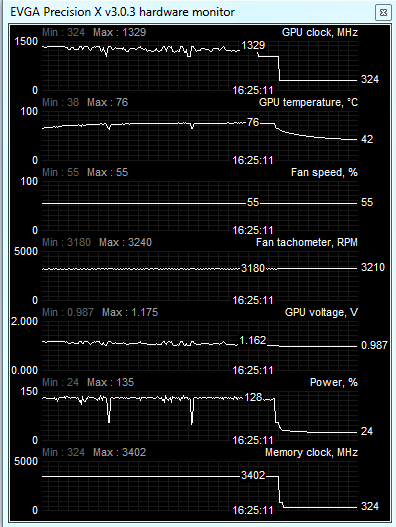
It can be said that the thermals are good. As long as the card runs at its factory clock of 1111MHz, GPU temperature won’t go over 72°C. Although we’ve seen some better performing GTX 680 coolers so far, we can’t take away from the fact that the Classified ran quietly both when gaming and idling. However, overclocking required us to increase the fan RPM.

The fan is limited to about 3240 RPM / 55%. The fan won’t go past this limit, which is most likely down to EVGA’s effort to keep noise down. Indeed, the fans got loud at these RPMs. We measured 63°C after our voltage-free overclock to 1161MHz (max. Boost 1239MHz) and the fan was running at its max.
After extreme overclocking over 1350MHz (boost clock), it was time for thermal throttling. We hit 80°C in no time, simply by playing more demanding games.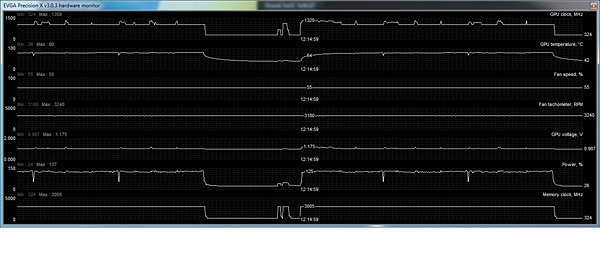
Consumption
Although the GTX 680 Classified has 4GB of memory and is factory overclocked, it consumes only about 10W more in average than the reference version. Overclocking and overvolting aren’t helpful in this respect either, and the maximum consumption we measured on the Classified was occasionally 50W higher than on the reference design.
EVGA GTX 680 Classified is made and aimed at enthusiasts and overclockers. This is why the card boasts an EVBot connector, the name that symbolizes EVGA-flavored overclocking. In fact, EVBot allowed for lighting fast overvolting of the GPU and memory. The card boasts 14+3 VRM design with two 8-pin power connectors. The cooler is large as well and the entire package suggests great fun.
Well, we had no shortage of fun – we can say that much. We spent a lot of time trying to hit 1300MHz (unless stated otherwise, GPU clock means Base GPU clock), but in vain. Perhaps we simply weren’t lucky enough to get a GPU that is capable of such a feat.
Part of the problem with overclocking limitations is the cooler itself. Namely, the cooler runs and cools the factory clocked GPU just fine, but extreme overclocking is a whole new ballgame. The GPU comes overclocked to 1111MHz while the memory was left at reference clocks. During our testing, we measured GPU Boost clocks up to 1211MHz. The cooler remained quiet after long sessions of Crysis 2 and temperatures didn’t exceed 72°C.
EVGA opted for the largest blower fan we’ve tested so far. EVGA replaced the reference 6.5cm fan with an 8cm one but although it looks quite powerful, its maximum RPM is locked at 55% / 3240 RPM. Although it’s not too loud at this RPM, you’ll hear it well. We think that Nvidia asked for the fan to be “restrained” and keep the card quiet. The cooler takes up only two slots, meaning that Quad SLI is possible.
The Base clock of 1260MHz quickly pushed the card to 80°C, which then triggered the downclocking to factory clocks. It’s no coincidence that Kingpin went for LN2 to overclock the GPU to 2GHz (boost clock).
EVBot is purchased separately and will set you back about €60. We must say that it would be phenomenal if EVGA gave away EVBots with its GTX 680 Classified cards. Nvidia doesn’t’ support overvolting and, as such, isn’t too anxious to give a green light on sales of overvolted cards. There’s no need to worry because, regardless of whether you use EVBot or not warranty is not impacted by using EVBot.
The factory overclock itself may not stand out. But the card should be looked at for its overclocking ability, and over voltage using EVBot (advised at 0.0625v increments).
We’d normally advise average users to look elsewhere, unless they’re really bent on spending big. Indeed, EVGA as well as other Nvidia’s partners offer many quality graphics cards that are €100+ cheaper.
EVGA’s GTX 680 Classified packs 4GB of memory, which handled overclocking quite well. Although the 4GB of memory may not cater to everyone, e.g. those who focus on GPU overclocking, it can still help in squeezing out maximum performance. We’ve noticed that extreme overclocking of the GPU alone doesn’t yield as significant performance improvements as possible when the memory is overclocked as well.
EVGA’s GTX 680 Classified currently goes for €662 or $660. Going by the price alone, the card ranks among the priciest water cooled GTX 680 cards, which seems about right considering what the card aims for. If overvolting and overclocking aren't your cup of tea however, then you're probably better off picking up Point of View's GTX 680 TGT Charged Edition 4GB, which is pretty much identical except for the cooling and that €107 that will stay in your pocket. As for the GTX 680 Classified, quality tools always cost a pretty penny and ordinary prices are best left for ordinary cards. EVGA’s GTX 680 Classified is a great product if you like overclocking and have the right tools for the job, better cooling included.



